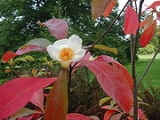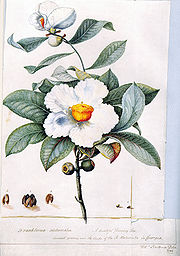
Franklinia
Encyclopedia

Camellia sinensis
Camellia sinensis is the species of plant whose leaves and leaf buds are used to produce Chinese tea. It is of the genus Camellia , a genus of flowering plants in the family Theaceae. White tea, green tea, oolong, pu-erh tea and black tea are all harvested from this species, but are processed...
family, Theaceae
Theaceae
The Theaceae is a family of flowering plants, composed of shrubs and trees. Some botanists include the family Ternstroemiaceae within the Theaceae while others do not...
. The sole species in this genus is a flowering tree, Franklinia alatamaha, commonly called the Franklin tree, and native to the Altamaha River
Altamaha River
The Altamaha River is a major river of the American state of Georgia. It flows generally eastward for 137 miles from its origin at the confluence of the Oconee River and Ocmulgee River towards the Atlantic Ocean, where it empties into the ocean near Brunswick, Georgia. There are no dams...
valley in Georgia
Georgia (U.S. state)
Georgia is a state located in the southeastern United States. It was established in 1732, the last of the original Thirteen Colonies. The state is named after King George II of Great Britain. Georgia was the fourth state to ratify the United States Constitution, on January 2, 1788...
in the southeastern United States
United States
The United States of America is a federal constitutional republic comprising fifty states and a federal district...
. It has been extinct in the wild
Extinct in the Wild
Extinct in the Wild is a conservation status assigned to species or lower taxa, the only known living members of which are being kept in captivity or as a naturalized population outside its historic range.-Examples:...
since the early 19th century, but survives as a cultivated ornamental tree.
In the past, some botanists have included Franklinia within the related genus Gordonia
Gordonia
Gordonia is a genus of flowering plants in the family Theaceae, related to Franklinia, Camellia and Stewartia. Of the roughly 40 species, all but two are native to southeast Asia in southern China, Taiwan and Indochina. The remaining species, G...
. The southeastern North American species Gordonia lasianthus differs in having evergreen
Evergreen
In botany, an evergreen plant is a plant that has leaves in all seasons. This contrasts with deciduous plants, which completely lose their foliage during the winter or dry season.There are many different kinds of evergreen plants, both trees and shrubs...
foliage, flowers with longer stems, winged seeds, and conical seed capsules
Capsule (fruit)
In botany a capsule is a type of simple, dry fruit produced by many species of flowering plants. A capsule is a structure composed of two or more carpels that in most cases is dehiscent, i.e. at maturity, it splits apart to release the seeds within. A few capsules are indehiscent, for example...
. (Franklinia was often known as Gordonia pubescens until the middle of the 20th century.)
Franklinia is now thought to be closer in relation to the Asian genus Schima
Schima
[[Schima is a [[genus]] of evergreen trees belonging to the tea family, [[Theaceae]].The genus inhabits warm temperate to subtropical climates across southern and southeastern Asia, from the eastern [[Himalaya]] of [[Nepal]] and eastern [[India]] across [[Indochina]], southern [[China]],...
. Recent DNA studies and examinations of floral ontogeny
Ontogeny
Ontogeny is the origin and the development of an organism – for example: from the fertilized egg to mature form. It covers in essence, the study of an organism's lifespan...
in the Theaceae place Franklinia together with Gordonia and Schima in a subtribe
Tribe (biology)
In biology, a tribe is a taxonomic rank between family and genus. It is sometimes subdivided into subtribes.Some examples include the tribes: Canini, Acalypheae, Hominini, Bombini, and Antidesmeae.-See also:* Biological classification* Rank...
. (Tsou 1998). Hybrid crosses have been produced between Franklinia alatamaha and Gordonia lasianthus, and between Franklinia alatamaha and Schima argentea. (Orton 1977; Ranney et al. 2003).
Description
Franklinia alatamaha is a deciduousDeciduous
Deciduous means "falling off at maturity" or "tending to fall off", and is typically used in reference to trees or shrubs that lose their leaves seasonally, and to the shedding of other plant structures such as petals after flowering or fruit when ripe...
large shrub
Shrub
A shrub or bush is distinguished from a tree by its multiple stems and shorter height, usually under 5–6 m tall. A large number of plants may become either shrubs or trees, depending on the growing conditions they experience...
or small tree
Tree
A tree is a perennial woody plant. It is most often defined as a woody plant that has many secondary branches supported clear of the ground on a single main stem or trunk with clear apical dominance. A minimum height specification at maturity is cited by some authors, varying from 3 m to...
growing to 10 m (32.8 ft) tall, but commonly 4.5–7.5 m (14.8–24.6 ft). It is commercially available for garden cultivation. It is prized for its fragrant white flowers, similar to camellia
Camellia
Camellia, the camellias, is a genus of flowering plants in the family Theaceae. They are found in eastern and southern Asia, from the Himalaya east to Korea and Indonesia. There are 100–250 described species, with some controversy over the exact number...
blossoms.it has flowers that smell like honeysuckles. The tree has a symmetrical, somewhat pyramidal shape, with different individuals of the species forming almost identical crowns. It forms several vertical trunks close to ground level. The bark is gray with vertical white striations and has a ridged texture. The alternate, obovate leaves are up to 6 in (15.2 cm) in length and turn a bright orange-red in the fall. Although difficult to transplant, once established Franklinia can live a century or more.
Franklinia fruit
Fruit
In broad terms, a fruit is a structure of a plant that contains its seeds.The term has different meanings dependent on context. In non-technical usage, such as food preparation, fruit normally means the fleshy seed-associated structures of certain plants that are sweet and edible in the raw state,...
develops slowly. The seed capsules
Capsule (fruit)
In botany a capsule is a type of simple, dry fruit produced by many species of flowering plants. A capsule is a structure composed of two or more carpels that in most cases is dehiscent, i.e. at maturity, it splits apart to release the seeds within. A few capsules are indehiscent, for example...
require 12–14 months to mature. When ripe the 5-valved spherical capsules split
Dehiscence (botany)
Dehiscence is the opening, at maturity, in a pre-defined way, of a plant structure, such as a fruit, anther, or sporangium, to release its contents. Sometimes this involves the complete detachment of a part. Structures that open in this way are said to be dehiscent...
above and below in a unique manner. Anecdotal evidence suggests viable seed production is enhanced where two or more plants are present in close proximity.
History
Philadelphia botanists JohnJohn Bartram
*Hoffmann, Nancy E. and John C. Van Horne, eds., America’s Curious Botanist: A Tercentennial Reappraisal of John Bartram 1699-1777. Memoirs of the American Philosophical Society, vol. 243. ....
and William Bartram
William Bartram
William Bartram was an American naturalist. The son of Ann and John Bartram, William Bartram and his twin sister Elizabeth were born in Kingsessing, Pennsylvania, near Philadelphia. As a boy, he accompanied his father on many of his travels, to the Catskill Mountains, the New Jersey Pine Barrens,...
first observed the tree growing along the Altamaha River
Altamaha River
The Altamaha River is a major river of the American state of Georgia. It flows generally eastward for 137 miles from its origin at the confluence of the Oconee River and Ocmulgee River towards the Atlantic Ocean, where it empties into the ocean near Brunswick, Georgia. There are no dams...
near Fort Barrington in the British colony of Georgia
Georgia (U.S. state)
Georgia is a state located in the southeastern United States. It was established in 1732, the last of the original Thirteen Colonies. The state is named after King George II of Great Britain. Georgia was the fourth state to ratify the United States Constitution, on January 2, 1788...
in October 1765. John Bartram recorded "severall very curious shrubs" in his journal entry for October 1, 1765. William Bartram returned several times to the same location on the Altamaha during a collecting trip to the American South, funded by Dr. John Fothergill of London. William Bartram collected Franklinia seed
Seed
A seed is a small embryonic plant enclosed in a covering called the seed coat, usually with some stored food. It is the product of the ripened ovule of gymnosperm and angiosperm plants which occurs after fertilization and some growth within the mother plant...
s during this extended trip to the South from 1773 through 1776, a journey described in his book Bartram's Travels
Bartram's Travels
Bartram's Travels is the short title of naturalist William Bartram's historically significant book describing his travels in the American South and encounters with American Indians between 1773 and 1777...
published in Philadelphia in 1791. William Bartram brought seed of Franklinia back to Philadelphia in 1777, and had flowering plants by 1781. After several years of study, Bartram assigned the “rare and elegant flowering shrub,” to a new genus Franklinia, named in honor of his father's great friend Benjamin Franklin
Benjamin Franklin
Dr. Benjamin Franklin was one of the Founding Fathers of the United States. A noted polymath, Franklin was a leading author, printer, political theorist, politician, postmaster, scientist, musician, inventor, satirist, civic activist, statesman, and diplomat...
. The new plant name, Franklinia alatamaha was first published by a Bartram cousin, Humphry Marshall in 1785 in his catalogue of North American trees and shrubs entitled Arbustrum Americanum. (Marshall 1785: 48-50; Fry 2001).
William Bartram was the first to report the extremely limited distribution of Franklinia. "We never saw it grow in any other place, nor have I ever since seen it growing wild, in all my travels, from Pennsylvania to Point Coupe, on the banks of the Mississippi, which must be allowed a very singular and unaccountable circumstance; at this place there are two or 3 acres (12,140.6 m²) of ground where it grows plentifully." (W. Bartram 1791: 468).
The tree was last verified in the wild in 1803 by the English plant collector John Lyon, (although there are hints it may have been present into at least the 1840s. See: Bozeman and Rogers 1986). The cause of its extinction in the wild is not known, but has been attributed to a number of causes including fire, flood, overcollection by plant collectors, and fungal
Fungus
A fungus is a member of a large group of eukaryotic organisms that includes microorganisms such as yeasts and molds , as well as the more familiar mushrooms. These organisms are classified as a kingdom, Fungi, which is separate from plants, animals, and bacteria...
disease
Disease
A disease is an abnormal condition affecting the body of an organism. It is often construed to be a medical condition associated with specific symptoms and signs. It may be caused by external factors, such as infectious disease, or it may be caused by internal dysfunctions, such as autoimmune...
introduced with the cultivation of cotton
Cotton
Cotton is a soft, fluffy staple fiber that grows in a boll, or protective capsule, around the seeds of cotton plants of the genus Gossypium. The fiber is almost pure cellulose. The botanical purpose of cotton fiber is to aid in seed dispersal....
plants. (Dirr 1998: 390-391).
All the Franklin trees known to exist today are descended from seed collected by William Bartram and propagated at Bartram's Garden
Bartram's Garden
Bartram's Garden which covers is the oldest surviving botanic garden in North America, including an historic botanical garden and arboretum , located on the west bank of the Schuylkill River in Fairmount Park, near the intersection of 54th Street and Lindbergh Boulevard, Philadelphia, Pennsylvania...
in Philadelphia.

